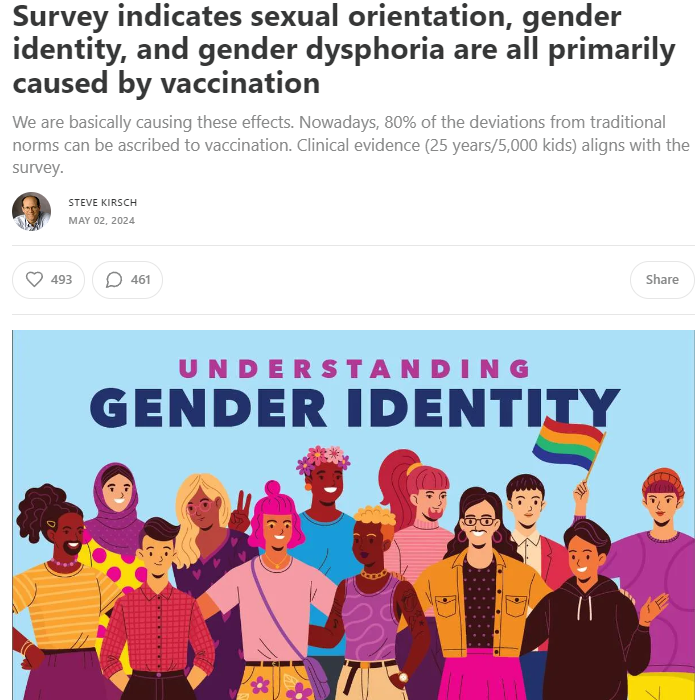Steve Kirsch did a “ground-breaking survey to explore the nuances between gender identity, sexual orientation, and gender dysphoria.”
He asked all those who are, or know someone extremely well who have sexual orientation, gender identity and/or gender dysphoria traits that differ from traditional norms to fill out a short anonymous survey. Kirsch added that he already possesses ground breaking results but he wanted to get more data to get to higher levels of statistical importance. This was the survey.
The answer to the question as to whether sexual orientation, gender identity and gender dysphoria are influenced by vaccines was yes: “the greater someone is vaccinated, the more likely they are to exhibit each of these traits.”
“For all three measures, the odds ratios were 4.8 or higher which means that the attributable fraction is 79.2%. In other words, vaccines are responsible for nearly 80% of the effect size”.
The source data is here. The analysis is here.
The odds ratio between the fully vaccinated/fully unvaccinated. Odds ratios >2 are traditionally associated with causality:
- Sexual orientation: 4.78
- Gender identity: 4.81
- Gender dysphoria: 5.54
Also, the odds ratios for partially vaccinated are in line with the fully vaccinated: in general, the greater the number of vaccines someone has, the more likely they are to have a trait that differs from traditional norms.
So the vaccines themselves are the elephant in the room here and the driver of the response, not environment, upbringing, social pressure, etc”.
Kirsch added that he had not seen any data that disputed this.
For the past 25 years, there have been no gender or sexual cases at a pediatric clinic. With over 5,000 children, there have been no cases. They don’t get immunized. Over.5% of people have orientation tendencies overall. Hence, out of 5,000 children who were not jabbed, there were supposed to be 25 cases, but none. There is a 1.39e-11 chance that this will occur by chance. So it wasn’t misfortune. The absence of vaccinations was the only significant change made by this pediatric practice. That’s an intriguing data point, and one that would be hard to ignore if something other than vaccinations was the main reason (for example, in 80% of the cases).
There is a plausible biological explanation for the rise in gender dysphoria in women relative to men, for example. Let’s evaluate this theory: the CDC in America approved the hepatitis A vaccine schedule in 2004. The regimen suggests receiving that vaccination in two doses. That vaccination is generated in male DNA or contains male DNA. MRC-5 specifically. Now, if the two additional dosages of male DNA are going to have an impact on young girls, puberty would be the logical “sweet spot” for when it would start to manifest, right? People in the transgender community will tell you that 2016 was a turning point in the number of girls wishing to transition into boys. I assume there were six or seven times as many male to female transitions before to 2016 than female to male transitions. Things abruptly began to balance out or come to a 50-50 split in 2016. And given that there are currently roughly 50% male to female and 50% female to male transitions, why would the girls have suddenly developed a strong desire to be boys when this wasn’t a major component before? Adding 12 years to 2004 and assuming that the typical duration of puberty is around 12 years old gets you to 2016.
Thus, what appeared to be a turning point that occurred in 2016 very likely began biologically in 2004.

